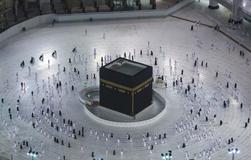 Saudis and foreign residents circumambulate (Tawaf) the Kaaba in the Grand Mosque complex in the holy city of Mecca, on October 4, 2020, as authorities partially resume the year-round Umrah for a limited number of pilgrims amid extensive health precautions after a seven-month coronavirus hiatus. (PHOTO / AFP)
Saudis and foreign residents circumambulate (Tawaf) the Kaaba in the Grand Mosque complex in the holy city of Mecca, on October 4, 2020, as authorities partially resume the year-round Umrah for a limited number of pilgrims amid extensive health precautions after a seven-month coronavirus hiatus. (PHOTO / AFP)
MECCA, Saudi Arabia - Mecca slowly stirred from a seven-month hibernation on Sunday as pilgrims trickled in after Saudi Arabian authorities partially lifted a coronavirus ban on performing umrah - a pilgrimage to Islam’s two holiest sites that is undertaken at any time of year.
Millions of Muslims from around the world usually descend on Saudi Arabia for the umrah and haj Islamic pilgrimages. The two share common rites, but the haj, held once a year, is the main lengthier ritual that is a once-in-a-lifetime duty for Muslims.
Millions of Muslims from around the world usually descend on Saudi Arabia for the umrah and haj Islamic pilgrimages. The two share common rites, but the haj, held once a year, is the main lengthier ritual that is a once-in-a-lifetime duty for Muslims
ALSO READ: Hajj pilgrimage in the age of coronavirus is unlike any before
Saudi Arabia, which held a largely symbolic haj earlier this year limited to domestic worshippers, has allowed citizens and residents to start performing umrah as of Sunday at 30 percent capacity, or 6,000 pilgrims a day. It will open for Muslims from abroad starting Nov. 1.
Last year the Gulf state drew 19 million umrah visitors.
“All of Mecca is happy today, it’s like the end of a jail term. We have missed the spiritual feeling of pilgrims roaming the city,” said Yasser al-Zahrani, who became a full time Uber driver after losing his construction job during a three-month national lockdown imposed in March.
“I pray we never go through the past few months again, it was a nightmare ... there was barely any work to cover my bills,” he told Reuters.
ALSO READ: Muslim hajj pilgrims ascend Mount Arafat for day of worship
Before the pandemic, more than 1,300 hotels and hundreds of stores buzzed around the clock to cater to pilgrims visiting the holy cities of Mecca and Medina.
Now many are closed, the windows of some gathering dust.
At midnight, tens of registered pilgrims wearing face masks prepared to enter the Grand Mosque in small groups.
As they circled the Kaaba, a stone structure that is the most sacred in Islam and the direction which Muslims face to pray, officials made sure they kept a safe distance apart.
Worshippers are no longer allowed to touch the Kaaba, which is draped in black cloth adorned with Arabic calligraphy in gold.
NEW REALITY
Pilgrimage is the backbone of a plan to expand tourism under Crown Prince Mohammed bin Salman’s drive to diversify the economy of the world’s top oil exporter. It aimed to boost umrah visitors to 15 million by 2020, a plan disrupted by coronavirus, and to 30 million by 2030.
Religious pilgrimage generates US$12 billion in revenues from worshippers’ lodging, transport, gifts, food and fees, according to official data.
Saudi Arabia hosted a drastically reduced haj in late July for the first time in modern history, with a few thousand domestic pilgrims instead of the usual white-clad sea of some 3 million Muslims.
Near the Grand Mosque, the hotels at high-rise towers were mostly empty and shopping malls closed hours before the resumption of umrah. Dozens of stores and restaurants were shut.
READ MORE: Over 2 million Muslims in Mecca for start of hajj pilgrimage
Economists have estimated Mecca’s hotel sector may lose at least 40 percent of pilgrimage-driven income this year.
Five hotel workers, who declined to be identified, said they were put on unpaid leave during the lockdown and said hundreds of others in the hospitality sector were laid off.
“It is hard to think that this will be the new normal, I pray every day for the corona to end,” Zahrani said.


